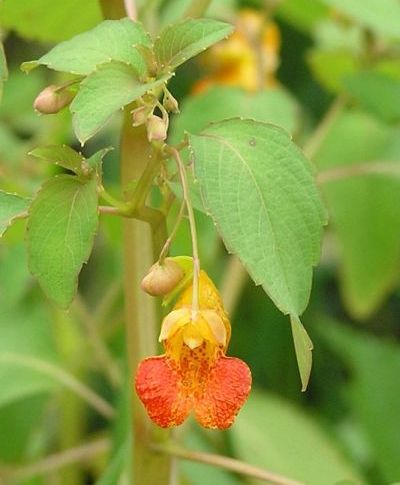
Jewelweed flowers (Impatiens capensis) offer inviting landing pads for bumblebees. The “jewel” in the name comes from the way water beads up on the leaves and sparkles like diamonds in the sun.
This plant is also called Spotted Touch-me-not because the flowers are spotted and the ripe seed pods explode when you touch them as if to say “Touch Me Not.”
The explosions are so cool that I am tempted to touch the plant even more. I make it a contest and try to beat the seeds at their own game. Whenever I find Jewelweed I look for the fattest seed pods and give each one a squeeze to see if I can capture the seeds before they leap from my finger tips. I always lose unless I cup my hand around the pod.
(photo by Dianne Machesney)
The bumble bees love the jewel weed. When I first saw the translucent stems growing in my yard, I didn’t know what they were. I don’t remember ever seeing jewel weed before we moved into our current house, but I wasn’t so much into native flowers before then. We get a lot of the “pale” yellow variety, which I’ve read is less common.
Jewel weed grows throughout my unkempt, unmulched mulch beds around my house. My neighbors must be horrified by the “weeds” (thistle, chicory, goldenrod, jewel weed, queen anne’s lace, sneezeweed, evening primrose, and other assorted wildflowers that have seeded themselves there) that grow around my house, but the bees, birds, and butterflies love it. I let a few thistles (not Canadian, too invasive) grow around the house and the goldfinches flock to them, and also to the chicory, which surprised me.
I too have the “weeds”(now they call them natives) around for the hummers, birds and butterflies…the hummers and the bees and even swallowtail butterflies love to sip the nectar of the jewelweed…did you know there is a male and female stage? This according to the Stokes Nature Guide, a Guide to Enjoying Wildflowers…(borrowed and wish I had my own Nature Guide Series).
You can tell the male stage by looking into the mouth of the flower and the top of the opening…If there is whitish pollen there, this is the male stage and if there is a small green point, the flower is in the female stage…(works for your impatiens also.)
I have the orange, pink to ruby red and the yellow-which is bigger in size with the flower, leaves and plant.
I have been popping these since I was really little and always stopped to see if they were “ready”…..and still do.
I’ve always used jewel weed as a nautral antidote for poison ivy. If you know you’ve been exposed, crush a few basal on the contact area. I know of one woodsman who puts a cup of leaves into a blender with a cup of water. He pours the mixture into his bath before he heads into the woods as a preventitive measure. I’m immune to poison ivy, but I’ve seen jewel weed do a great job in preventing the rash and blisters in others.
Where I grew up on the Penn Hills/Wilkins Township Border, we had a large woods behind our back yard. The jewel weed there was just yellow, and there was lots of it, particularly on the edge of the woods. In the woods itself, there were Jack-in-the pulpits, mayapple and bloodroot. The mayapple grew in big patches and the the bloodroot was in patches too. There were massive black cherry trees with dark gray/black bark that was flakey looking like potato chips, also many american elm trees with large pointy leaves that were sand-paper rough with sawtoothed edges. I used to love to look for that place where the sides of the leaves meet unevenly at the stem.
There were wild grapevines and we would look for the ones that were strong enough that we could swing on them Tarzan-style. There was Solomon’s seal – or maybe it was false Solomon’s seal – I wasn’t discerning then – just a bored 14 year-old with nothing to do but wander and look, and feel like every one of those lovely plants was my friend. In those days there was a pheasant, and rabbits. but in more recent years there are occasional turkeys instead – I hear. And deer. Someone else has our woods now. I hope they befriend it too.